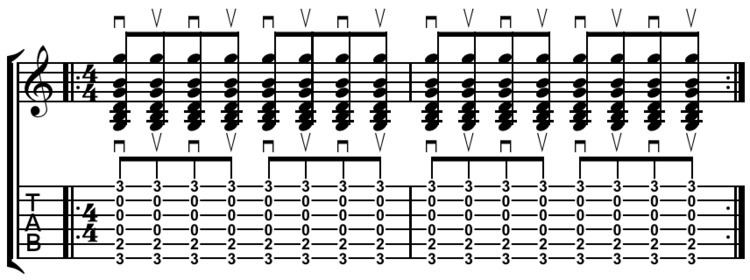 | ||
In music, strumming is a way of playing a stringed instrument such as a guitar. A strum or stroke is a sweeping action where a fingernail or plectrum brushes past several strings in order to set them all into motion and thereby play a chord. Strums are executed by the dominant hand, while the other hand holds down notes on the fretboard. Strums are contrasted with plucking, as a means of activating strings into audible vibration, because in plucking, only one string is activated by a surface at a time. A hand-held pick or plectrum can only be used to pluck one string at a time, but multiple strings can be strummed by one. Plucking multiple strings simultaneously requires a fingerstyle or fingerpick technique.
Contents
A strumming pattern or strum is a preset pattern used by a rhythm guitar. Compare with pattern picking, strumming patterns may be indicated through notation, tablature, up and down arrows, or slashes. For example, a pattern in common time or 4
4 consisting of alternating down and up eight note strokes may be written:
Rock and Pop
The pattern most typical of rock and related styles would be written:
/ / /Patterns may alternate or vary through one song.
Examples of primary strumming patterns in songs:
Jazz and Funk
The simple four-to-a-bar rhythm is associated with Jazz guitarists such as Freddie Green, although they may subtly vary the chord on each beat.
A simple eight-to-a-bar rhythm is known as "straight eights" as opposed "swung eights", in which each pair are played as the first and third notes in a triplet.
The fretting hand can also be lifted off the fretboard to damp a chord, creating staccato and percussive effects. In reggae and ska, a few staccato "chops" are played per bar. In funk rhythm playing, the strumming hand keeps a fairly steady motion in 16th notes, while the left hand, basically holding down a jazz chord damps some of them in a syncopated pattern.
Fingerstyle strumming strokes
Some of the many possible fingerstyle strums include
